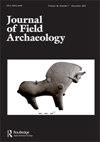Animal Economy in Hellenistic Greece: A Zooarchaeological Study from Pherae (Thessaly)
IF 1.5
1区 历史学
0 ARCHAEOLOGY
引用次数: 0
Abstract
ABSTRACT The scale of animal husbandry in ancient Greece has been debated for decades. To contribute to this debate, we examined faunal assemblages from Pherae in central Greece using non-destructive zooarchaeological methods. The results show that Pherae was involved in a caprine-oriented husbandry. The limited mobility of domesticated animals, indicated by mortality profiles, suggests that small-scale animal husbandry was the norm. Meat was redistributed across the town, and the quality of meat a household consumed depended on that household’s financial status. These results lead us to propose an economic model whereby both small-scale and semi-specialized animal husbandry were practiced, corroborating arguments for multiple co-existing animal husbandry practices in ancient Greece. Unlike in other parts of the Roman Empire, the predominance of caprines, indications of their use in meat and dairy production, and their relatively small “Hellenistic” size suggests that the Roman presence in Pherae did not influence animal economy.希腊化希腊的动物经济:Pherae(色萨利)的动物考古研究
关于古希腊畜牧业的规模,人们争论了几十年。为了对这一争论做出贡献,我们使用非破坏性的动物考古学方法研究了希腊中部费莱的动物群。结果表明,费拉参与了以辣椒碱为主的畜牧业。家畜的有限流动性,从死亡率曲线上可以看出,表明小规模畜牧业是常态。肉在镇上被重新分配,一个家庭消费的肉的质量取决于这个家庭的经济状况。这些结果使我们提出了一种小规模和半专业化畜牧业同时存在的经济模式,证实了古希腊多种畜牧业共存的论点。与罗马帝国的其他地区不同,绵羊的优势,它们在肉类和乳制品生产中的使用的迹象,以及它们相对较小的“希腊化”规模表明,罗马人在费拉的存在并没有影响动物经济。
本文章由计算机程序翻译,如有差异,请以英文原文为准。
求助全文
约1分钟内获得全文
求助全文
来源期刊

JOURNAL OF FIELD ARCHAEOLOGY
ARCHAEOLOGY-
CiteScore
4.60
自引率
5.30%
发文量
29
期刊介绍:
The Journal of Field Archaeology is an international, refereed journal serving the interests of archaeologists, anthropologists, historians, scientists, and others concerned with the recovery and interpretation of archaeological data. Its scope is worldwide and is not confined to any particular time period. Contributions in English are welcomed from all countries.
 求助内容:
求助内容: 应助结果提醒方式:
应助结果提醒方式:


